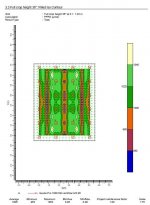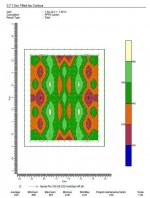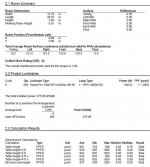Beta Test Team
Member
I'm not wrong, you just agreed with what I wrote. That you're using the 1000 PPF (the same things as PPFD) as an average of many umol/s values, i.e. in some areas (like below the lamp) the umol/s will be above 1000, and other areas (near the corners and edges) will be below 1000. However, now I see Gavita doesn't know PPFD means the irradiance over a meter squared (from what you wrote) - but that doesn't change my point, you're averaging to get that 1000 umol/s value.Beta test team I am sorry but you are very wrong. When we say 1000 umol we mean 1000 umol ppfd over the canopy with a uniformity of 90 percent at least. We do not get hot spots in our light plans.Beta Test Team said:Yes, 1,000 umol is too much (especially per day), and the way Gavita measures that umol is also not correct, or, should I say, not the 'whole picture'; it's not the average of umol over 3'x3' that matters, but the umol per much smaller area, this is about uniformity, which Gavita severely lacks.
For example, to reach 1,000 umol average, there will be spots on the canopy with well above 1,200, up to 1,500 umol, as well as spots that are well below 600 umol, down to 200 or 300 umol.
If your number of fixtures isn't important, and you really want to use Gavita, I would pack them in and dim them to somewhere between 60% and 80%. That way you can reach a target umol (like 800, or 1,000 if you wish) while also having better uniformity than you would if running Gavita's at 100% and using fewer of them.
Oh yea, without a quantum sensor (https://www.icmag.com/ic/showthread.php?t=298086) you really can't be sure what umol you're providing. You can't go by Gavita's suggestions because each room is different in terms of various factors affecting radiation.
https://www.icmag.com/ic/showthread.php?t=297147
https://www.icmag.com/ic/showpost.ph...5&postcount=10
https://www.icmag.com/ic/showpost.ph...2&postcount=12
The data you guys should provide is min and max umol/s over 3'x3' area, as well as average, which is the only way to get the true PPF (average of all umol/s values over that 3'x3' area).
And how are you even defining "90 percent"? Percent of what?
The fact you claim you "do not get hot spots in our light plans" is very bold, and one the requires strong evidence (like the figures I posted below). Because even with the one of the best setups in the world (see below), there are hot spots.
I have personally tested Gavita uniformity in rooms (with LI-COR quantum sensors) where the growers followed Gavita install advise, and there were always large differences in the min and max umol/s/density values - in other words, hot-spots and not great uniformity.
For example, here's our Greenbeams values. If Gavita could provide anything close to this uniformity (see the "Min" and "Max" values over a square meter) I would eat my hat:
If Gavita doesn't know "PPFD," "PAR," and "PPF" all are the same thing, and all are defined as umol/s over a meter squared in PAR range, then you guys are ones that are bonkers, sorry to say.Who says we measure over a 3x3? That is ridiculous. This grid tests are totally bonkers. They prove that a deep reflector will give you more light under the reflector, nothing else. We do not use grid tests and we definitely do not recommend to hang our lamps in square 5x5 grids.
What this shows is the poor uniformity of Gavita, it has a strong hot-spot below the lamp. Granted, overlap from otehr fixtures reduced the min to max difference, but the Gavita still have a considerable hot-spot below the lamp.
My point was to increase uniformity, which is severely lacking from Gavita in many grow rooms I've tested with our quantum sensors (after they followed Gavita install advise). Not to optimize photosynthetic efficiency (as umol/s in PAR range per joule).Secondly your advice to run them dimmed totally discredits you completely. If you were informed you would know that the efficiency will drop when you dim a lamp. Haven't you read this thread at all?
I hope this doesn't seem like I don't like Gavita, I think they're really good, just not optimal due the poor uniformity. That's why I always suggest ePapillion, because even though the photosynthetic efficiency is less than Gavita, the uniformity is better (leading to more uniform plant growth and better yields).
No, I haven't read this whole thread. There's no need to read it. What I wrote is correct.
Last edited:





